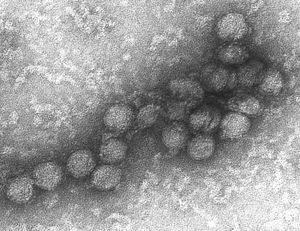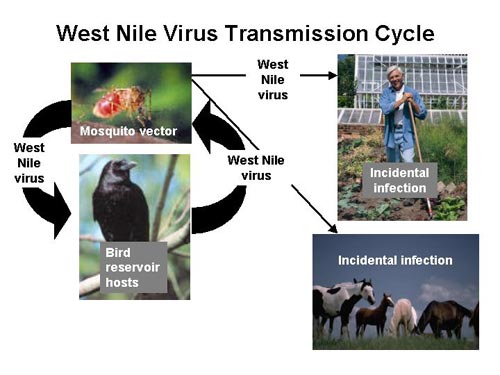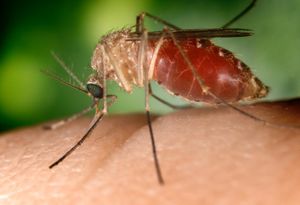West Nile Virus
Introduction
The West Nile Virus (WNV) is a neurotropic human pathogen. This virus belongs to the flavivirus genus which is in the Flaviviridae family along with the dengue virus and the yellow fever virus. The West Nile Virus is a mosquito-borne virus and affects many other animals besides humans, such as birds, reptiles and other mammals. The WNV is mainly found in tropical and temperate regions around the world and was first discovered in Uganda in 1937. The first major outbreak of the disease occurred in 1994 in Algeria and it finally hit the western hemisphere in New York in 1999. Many humans who do become infected with the disease are subclinical where they do not show any symptoms however transmission of the WNV can result in the West Nile Fever. The West Nile Fever, not always, but can affect the central nervous system and lead to a neurological disease.
Structure and Function
RNA and Proteins
The West Nile Virus is and enveloped virion that contains a positive single stranded genome. The genome is about 11 kb of a single open reading frame [1]. The viral RNA is translated to produce three structural and 7 nonstructural proteins. The structural proteins are capsid, envelope, and premembrane proteins and the nonstructural proteins include, NS1, NS2A, NS2B, NS3, NS4A, NS4B, and NS5. The structural proteins are encoded at the 5’ end of the RNA strand and serve the function of virus entry and encapsulation of the genome [1]. The nonstructural proteins serve multiple functions due to the limited number of proteins present in the genome. NS1 does not have an exact role in viron assembly however it has been speculated to help in the replication process [2]. NS2A, NS2B, NS4A, and NS4B inhibit the inate immune response against viral infection in the body [3]. NS3 is the protease that cleaves other nonstructural proteins from the polyprotein and encodes enzyme activities [4]. The NS5 protein is essential for viral replication due to the fact that it is the polymerase that encodes a methltransferase [4].
Life Cycle
The West Nile Virus enters the cell through receptor-mediated endocytosis. It is still unsure of what receptor proteins are responsible for the endocytosis of this virus. Once the virus is internalized in the cell, the virus matures as the pH drops to become slightly acidic within the envelope. Once the endosome has matured the envelope protein undergoes conformational changes where the endocytic membrane fuses with the viral lipid membrane. This causes the release of the viral RNA genome into the cytoplasm of the cell. Once released into the cell the single RNA is replicated and translated into proteins. The viral RNA is replicated by both cellular and viral proteins. The 3 structural proteins expressed from the viral RNA assemble onto the membranes in the endoplasmic reticulum and bud into the cytoplasm by the Golgi network. The virus exits the cell in a lipid envelope through exocytosis when cellular enzymes cleave the prM [1].
Pathogenesis
Vectors
Mosquitos are the main vectors of the West Nile. They acquire the virus after ingesting the blood from a viremic animal. The virus infects the cells of the mosquito by replicating in the cells of the midgut while the blood is being digested. Once replicated, the virus travels through the hemolymph to the salivary glands. Given enough time this will lead to a high level of viremia in the saliva of the mosquito which can then be transmitted to other organisms when they are feeding.
Host Reservoirs
Many different types of mosquito species can carry the West Nile Virus. The most common mosquito vector of the United States is C. tarsali.[1]. Mosquitos feed on a variety of organisms which makes it quite easy to spread the disease. Birds are the most common host reservoir for this disease since many species can have the disease yet show no signs or symptoms. The West Nile virus is maintained in the environment through this constant cycle between animal hosts and mosquitos. Birds are also a prime target as a host reservoir because they can carry high levels of viremia in their blood whereas humans cannot and are considered a dead end hosts
Transmission to Host Organism
The West Nile virus is transmitted from the mosquito to the host organism when the mosquito begins the probing process of blood feeding. During the probing process the proboscis of the mosquito injects the skin of the organism with pharmacologically active saliva proteins to locate the blood source. In a study performed by Styler (2011) it was shown that when the West Nile virus is transmitted by mosquitos the viremia of the host organism is significantly higher than when the virus is transmitted with only a syringe. This suggests that mosquito saliva plays an important role in enhancing the transmission and survival of the West Nile virus in host organisms [6]. Since there is such a great amount of selective pressure upon mosquito saliva from the host immune system it is likely that the West Nile virus coevolved in order to use saliva proteins to their advantage. It is still unsure of how the virus coevolved or what proteins contribute to the success of the virus [1]. Finally it has been shown that the saliva from mosquitos also decreases immune response from the host organism. When the West Nile virus was transmitted with mosquito saliva there was a reduction in T cells recruited to the inoculation site compared to when the virus was transmitted alone [7]. The exact mechanisms and proteins used in mosquito saliva to enhance the West Nile virus is still unclear.
Immune Response
References
1. Colpitts, Tonya M. 2012. "West Nile Virus: Biology, Transmission, and Human Infection." Clinical microbiology reviews 25.pp 635-648
2. Westaway E.G., Mackenzie J.M., Khromykh A.A. 2002. "Replication and gene function in Kunjin virus." Current Topics in Microbiology and Immunology Volume 267, 2002, pp 323-351.
3. Liu WJ, Chen HB, Wang XJ, Huang H, Khromykh AA. 2004. "Analysis of adaptive mutations in Kunjin virus replicon RNA reveals a novel role for the flavivirus nonstructural protein NS2A in inhibition of beta interferon promoter-driven transcription." J. Virol. 78:12225–12235
4. Lindenbach DR, CM. 2007. "Flaviviridae: the viruses and their replication."Fields Virology, 5th Edition. pp 991–1041.
5. Styer LM, et al. 2011. "Mosquito saliva causes enhancement of West Nile virus infection in mice." J. Virol. 85:1517-1527.
6.Schneider BS, et al. 2010. "Aedes aegypti saliva alters leukocyte recruitment and cytokine signaling by antigen-presenting cells during West Nile virus infection." PLoS ONE 5(7)
7. Lim, S.M., Koraka, P., Osterhaus, A., Martina, B. 2011. [http://www.ncbi.nlm.nih.gov/pmc/articles/PMC3185772/ "West Nile Virus: Immunity and Pathogenesis." Viruses 3(6). pp 811-828.



